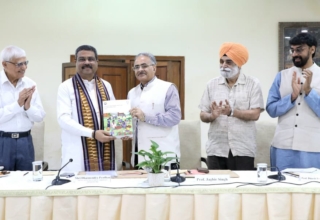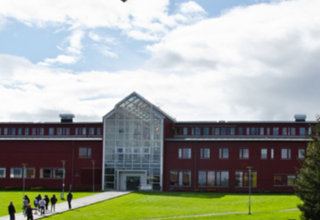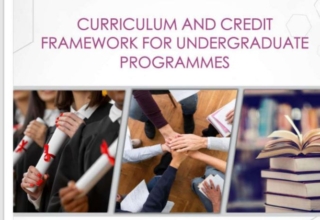
Technology Driven Education with Equity post-COVID
PM eVIDYA, a programme for multi-mode access to digital/online education to be launched immediately.
- Over 100 top universities will be permitted to start online courses by May end.
- DIKSHA to become ‘one nation, one digital platform’ for school education
- TV channel earmarked for each class from standard 1 to 12 under ‘one class one channel programme’, Community Radios to broadcast education content
- Special e-content for visually and hearing impaired students
- New National Curriculum and Pedagogical framework for school, early childhood and teachers will also be launched.
- National Foundational Literacy and Numeracy Mission for ensuring that every child attains Learning levels and outcomes in grade 5 by 2025 will be launched by December 2020.
Manodarpan, an initiative for psycho-social support for students, teachers and families for mental health and emotional well-being to be launched immediately as well.

Over 100 top universities will be permitted to start online courses by May end
Union Finance Minister, Nirmala Sitharaman, in her fifth part of Aatmnirbhar Bharat package press briefing on May 17, launched PM eVidya programme, a programme for multi-mode access to digital/online education with immediate effect. Under this programme, over 100 top universities will be permitted to start online courses by May 30.
“To provide enhanced learning opportunities to 3.7 crore students in higher education and expand e-learning by liberalizing open, distance, and online education regulatory framework, the top 100 universities will start online courses. Online components in conventional Universities and ODL programmes will also be raised from 20% to 40%,” the Union HRD minister Ramesh Pokhriyal Nishank said in a tweet..
DIKSHA to become ‘one nation, one digital platform’ for school education
DIKSHA, a MHRD online repository of NCERT content for K-12 will become ‘one nation, one digital platform’ for school education in states and union territories, FM Nirmala Seetharaman said in her fifth part of Aatmnirbhar Bharat package press briefing on May 17. Diksha will provide e- content and QR coded energised textbooks for all grades. This will benefit nearly 25 crore school going children across the country.
Over the next three month a large number of high-quality e- resources for learning and teaching will be made available on DIKSHA through the recently launched VidyaDaan Program. VidyaDaan is conceptualised as a common national program for individuals & organizations across the country to donate/contribute e-learning resources for school education to ensure continuity of quality learning.
DIKSHA has content in 14 languages – Assamese, Bengali, English, Gujarati, Hindi, Kannada, Malayalam, Marathi, Odia, Sindhi, Tamil, Telugu, Urdu, Chhattisgarhi.
TV channel earmarked for each class from standard 1 to 12 under ‘one class one channel programme’
In order to support and reach out to those who do not have much access to the internet, MHRD introduced SWAYAM PRABHA DTH channels. SWAYAM PRABHA is a group of 32 channels devoted to telecast of high-quality educational programmes.
Four of these channels (27- Panini, 28-Sharda, 30- Gyanamrit and 32- Vagda) are already being used by NIOS and one channel (31- Kishore Manch) by NCERT to telecast school education related learning and teaching material. These channels can be accessed through DD, Dish TV and Jio TV app.
NIOS organises live interactive web-streaming of Personal Contact Programmes (PCPs) on various subjects of Secondary, Senior Secondary and Vocational courses for its enrolled learners through Mukta Vidya Vani (MVV). Radio Vahini also broadcast these PCPs to maximize its reach not only among the learners but to the masses in general.
Radio & podcasts
There will be extensive use of radio, community radio and podcasts among students. The use of 289 Community Radio Stations will be attempted for school education.
Podcast called Shiksha Vani of CBSE disseminates audio content for various subjects of grades 9 to 12, in a timely, educative, lucid and seamless manner. CBSE-Shiksha Vani is available on Play Store for Android phone users. So far Shikshavani contains approximately 400 pieces of content in the form of audio files on topics in accordance with NCERT curriculum.
Special e-content for visually and hearing impaired students. “This is going to be one of the biggest steps forward and I personally feel very touched by this attempt of HRD ministry to provide equal access to good quality education to the Divyang students,” the finance minister said in a press conference.
Special e-content will be provided for visually and hearing impaired children. It is developed on Digitally Accessible Information System (DAISY) and in sign language on NIOS website/ YouTube, the HRD minister informed in a tweet.
For the Visually Impaired Learners
Study material has been developed in Digitally Accessible Information System(DAISY), a technical standard for digital audiobooks, periodicals and computerized text. Learners can access all study material of NIOS through DAISY. These lessons are broadcast on Gyanamrit, Channel 30 of Swayam Prabha
For the Hearing impaired learners
Course content (Selected ones) of NIOS has also been recorded in sign language which is placed on NIOS website as well as on YouTube. The recorded content is sent to HI learners on DVD. IITPAL for IITJEE/NEET preparation.
Other Programmes:
Finance minister Nirmala Sitharaman also talked about various other programmes for boosting the education system in a press conference on May 17.
1. Manordarpan: Finance minister also launched Manodarpan, an initiative for psychological support and counselling of students, teachers and families for mental health and emotional well-being.
2. New National Curriculum and Pedagogical framework for school, early childhood and teachers will also be launched. It will be integrated with global and 21st century skill requirements.
3. National Foundational Literacy and Numeracy Mission for ensuring that every child attains learning levels and outcomes in grade 5 by 2025 will be launched by December 2020
Reactions:
Rustom Kerawalla, Chairman,
Ampersand Group & Founder Chairman, VIBGYOR Group of Schools:- “The thrust
on online education by way of SWAYAM PRABHA DTH channels for reaching those who
do not have access to the internet addresses the challenges faced by a large
part of the student population. However, there has to be a stronger focus on
measuring effectiveness. The government needs to look at third-party credible
sources for making fair assessments.
The e-VIDYA programme for multi-mode access to digital or online education may
not be applicable to all age groups. The younger children cannot focus on
online modes without assistance or Parental Guidance and hence elders in the
family too should be trained to impart education. For the elder children,
earmarking a TV channel or extensive use of radio and podcasts needs to be
backed by practical on-ground training. The concept of ‘blended learning’ and
training teachers for the new modes of learning should not be missed by the
policymakers.
As announced for other sectors like Airports, Energy or Defence, the
Government should embrace Public-Private Partnerships (PPPs) more widely for
implementing these plans. PPPs can be involved for establishment, improvement or
management of new or existing education infrastructure in the country. This
would ensure fast track content creation, imparting training for the continuous
professional development of teachers, vocational training and for monitoring
outcome at the ground level.”
Nitin Potdar, Partner, J Sagar Associates:- “Technology driven education would leapfrog spread of education across the Country. It would democratise knowledge and skills. And the beneficiary would not just be the millions of students but even millions of adults who got deprived of education at home. Technology can get the best global teachers, unique teaching methods and their experiences at virtually zero cost that would be the real game changer for India.”
Narayanan Ramaswamy, National Head – Education and Skill Development, KPMG in India:- The announcements by the Finance Minister has far reaching beneficial implications for the Education sector. The measures have been designed to strengthen the fundamentals while supporting investments in Infrastructure. The DIKSHA platform has been strengthened both in terms of content as well as in terms or reach; with one channel per class till the 12th standard, over and above the existing 3 channels. Noteworthy is the initiative to provide content – rich interactive sessions by experts – clearly demonstrating the need to impart education digitally in a post Covid world.
Similarly Top 100 Universities being permitted to automatically start on-line courses is a major reform, and this will provide a big fillip to tertiary education – both in terms of reach and affordability. The Viability Gap Funding (VGF) for social projects announced earlier, will benefit many new Universities and higher Education institutions as well. We can expect more modern and future-relevant courses and a spurt in enrollments due to these announcements.
Dr Partha Chatterjee, Dean – International Partnerships, Professor and Head of the Economics Department, Shiv Nadar University : –“Allowing top 100 universities to run online courses, will useful. However, let us face it the biggest challenge is that a large segment of our population may not have access to infrastructure that is needed to carry on any meaningful learning. The focus has been mostly on creating TV channels and use of radio. However, these are not interactive media and inferior to even what online courses can achieve. More innovative thinking is needed. For example, can’t we open learning centers at block levels which will be equipped with good internet connections, computers, printers, etc.? Students can book time and come there and study and learn. Another huge impediment to starting schools and colleges in India will be lack of testing – it will be difficult to open up campuses if large scale testing is not possible.”
Monica Malhotra Kandhari, MD, MBD Group: “Launching the Swayam Prabha DTH channels for low internet penetration areas and roping in private DTH operators to air educational contents are much needed initiative that will help students. The announcement of an earmarked TV channel for classes 1 to 12 (one class, one channel) will go a long way in streamlining the delivery of online classes. The proposal to immediately launch a multi-modal access to digital education will greatly benefit students and also help formalise online education which is proving to be viable option for delivery of educational content especially when educational institutions across the country have been shut in response to the pandemic”.
“During this challenging time, many publishing groups went ahead and offered their resources, which include e-books, concept videos and assessments, free of cost to learners and teaching community to ensure that the learning of students does not suffer while observing lockdown protocol”, Monica further added.










